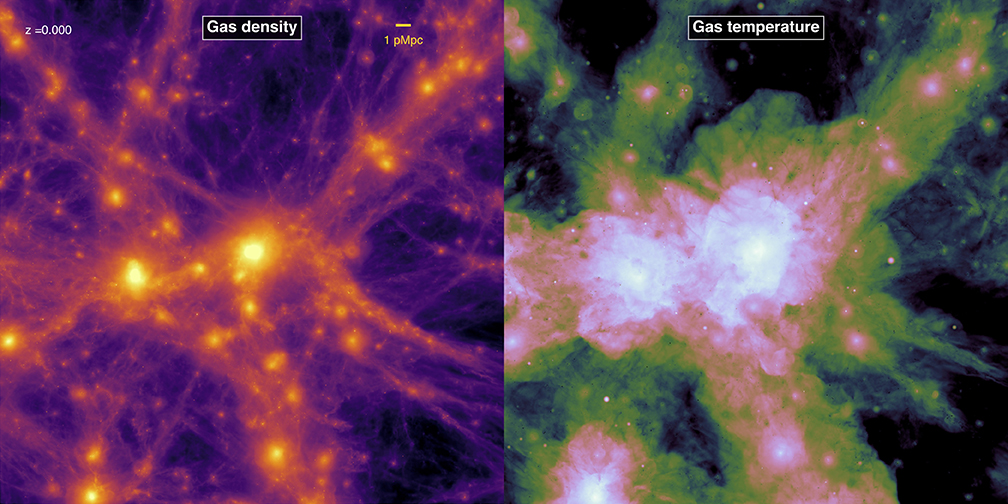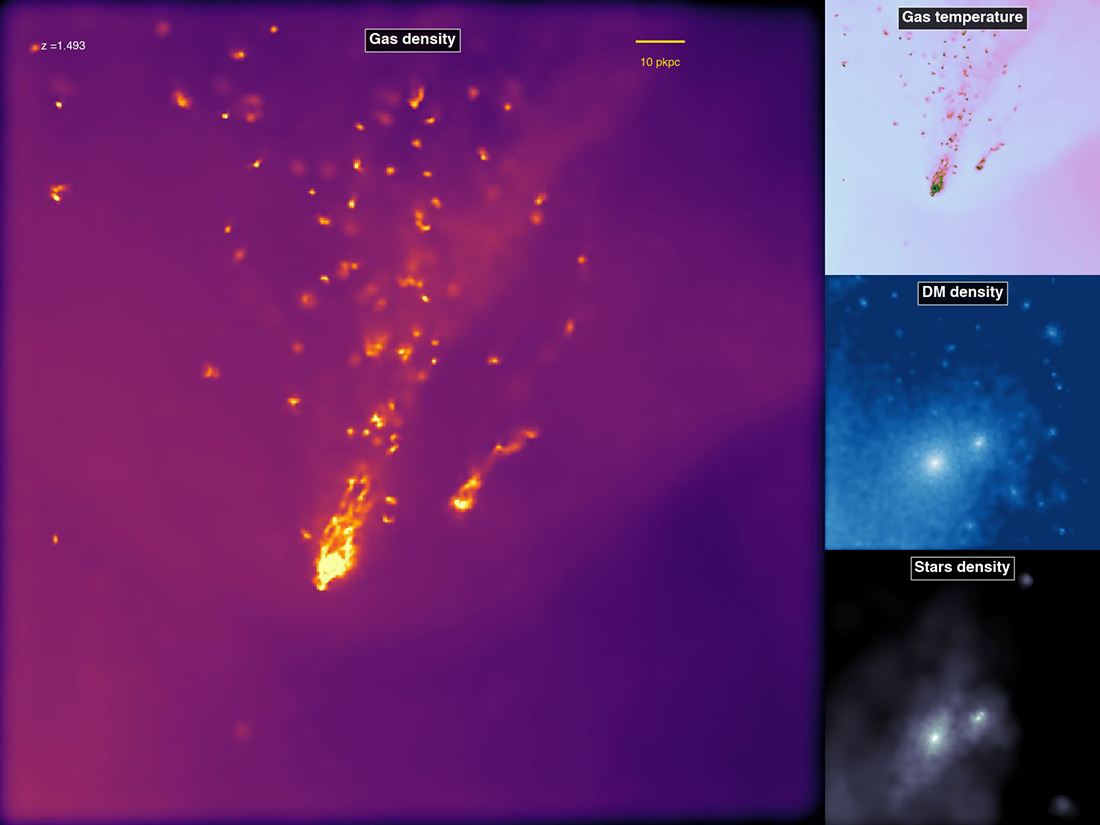ASTROPHYSICS
Hydrangea: Simulating the Formation of Galaxies in Clusters
Principal Investigator:
Yannick Bahé
Affiliation:
Max Planck Institut for Astrophysics, Garching (Germany)
Local Project ID:
gcs-hydra
HPC Platform used:
Hazel Hen of HLRS
Date published:
Why do galaxies that live in the enormous structures known as galaxy clusters look different from normal, isolated galaxies, like our Milky Way? To answer this question, astrophysicists have created the Hydrangea simulations, a suite of 24 high-resolution cosmological hydrodynamical simulations of galaxy clusters. Containing over 20,000 cluster galaxies in unprecedented detail and accuracy, these simulations are giving astrophysicists a powerful tool to understand how galaxies have formed and evolved in one of the most extreme environments of our Universe.
Galaxy clusters are giant associations of up to several thousand galaxies, embedded in ‘haloes’ of dark matter and hot gas. Observations have shown that these extreme environments leave imprints in the properties of the galaxies within them: while isolated galaxies often contain blue star-forming discs, cluster galaxies are mostly red, show an apparently featureless ‘elliptical’ morphology, and have stopped star formation several billion years ago. Understanding the origin of these differences is a major unsolved problem in contemporary astrophysics, and computer simulations are a promising tool to make progress.
The latest generation of these simulations, such as those produced by the EAGLE collaboration, have finally succeeded in producing galaxies that resemble those found in the real Universe in key properties such as their mass, size, and gas content, starting from the observed tiny density fluctuations in the early Universe. This makes them an ideal tool to study the physics of galaxy formation. However, galaxy clusters occupy only a tiny fraction of the Universe by volume and are therefore not well represented in the original EAGLE simulations.
The Hydrangea project, led by Dr. Yannick Bahé at MPA Garching and involving researchers in Germany, the UK, the Netherlands, and Spain, has filled this gap with a large suite of 24 'zoom-in' simulations. This technique focuses computing power on only a small region within a very large volume, carefully selected to contain a massive galaxy cluster. Even with this trick, the Hydrangea simulations constituted a major computational effort. This is due to the vast range of scales involved: with a galaxy cluster exceeding an individual galaxy in mass by more than a factor of 1000, adequately resolving individual cluster galaxies required simulations with several billion particles, which interact both gravitationally and hydrodynamically. The total computational cost of the suite therefore exceeded 40 million CPU hours (more than 4500 years in serial). Access to the large supercomputing facility Hazel Hen of HLRS, where the simulations could be run on more than 10,000 cores simultaneously, was therefore crucial for completing the project in less than one year.
In total, Hydrangea contains over 20,000 simulated galaxies. The analysis of the simulations is an ongoing effort that will take several years to complete. As well as testing the accuracy of the EAGLE model in the essentially unchartered regime of massive galaxy clusters, this effort will allow astrophysicists to gain groundbreaking new insight into how galaxies interact with their cluster environment. This will significantly improve our understanding of how the structures we see in the Universe formed and evolved over the last 13.7 billion years.

Fig. 1: One of the galaxy clusters simulated in the Hydrangea projects, with a mass of more than 1015 times the mass of our Sun. Projected gas density is shown on the left, gas temperature on the right (white is hottest, black coldest). Clearly visible are the extended haloes of hot (~100 million K) gas and myriads of long filaments stretching from the cluster into the surrounding Universe.
Copyright: MPA Garching
Fig. 2: Zoom-in to two individual simulated galaxies that are falling into a cluster, at a redshift of 1.5 (9 billion years before today). The long tails extending to the top-left are formed by gas that was stripped from the galaxies; this gas is cooler than the surrounding intra-cluster gas. The dark matter and stars are not significantly disturbed, indicating that the gas is stripped through hydrodynamical processes.
Copyright: MPA GarchingScientific Contact:
Dr. Yannick Bahé
Max Planck Institute for Astrophysics, Garching
Karl-Schwarzschild-Str. 1, D-85741 Garching (Germany)
e-mail: ybahe [at] MPA-Garching.MPG.DE
http://www.mpa-garching.mpg.de/